¶ Introduction
This article will present the main aerodrome markings and signalization on runways and taxiways.
¶ Runway Markings
This chapter will show the runway marking signs.
- Runway markings are white.
- The only exception is if a pre-threshold area is not suitable for normal movement of aircraft, but only serving as a stop way from the opposite end of the runway. The chevrons indicating such a prethreshold area are yellow markings.
¶ Marking requirements
Runway marking requirements differ per runway classification:

¶ Runway designator
The runway designator consists of a two digit number indicating the magnetic runway heading, rounded to the nearest 10 degrees.
Where parallel runways are located at an aerodrome with the same magnetic heading, the runway designator will include a letter R, L or C:
- "L" (Left) indicates the runway situated on the left as seen from the approach,
- "R" (Right) indicates the runway situated on the right.
- "C" (Centre) exists if there is a third parallel runway, the runway situated in the middle will be designated with the letter "C".
If there are more than 3 parallel runways, the runway designator number must change as per example:
- 1 runway = 26
- 2 runways = 26L, 26R
- 3 runways = 26L, 26C, 26R
- 4 runways = 26L, 26R, 27L, 27R
- 5 runways = 26L, 26C, 26R, 27L, 27R
¶ Runway centerline
Runway centreline markings are 30 meters long and separated by 30 meters between each mark.
¶ Runway Threshold marking
Runway threshold markings are depending on runway width:

¶ Pre-threshold marking
Pre-threshold marking is provided where a runway has:
- a displaced threshold
- a stop way
- a closed pre-threshold area
A displaced threshold is used where not all the runway is available for landing. The white arrows in the prethreshold area indicate that the surface is fit for ground movement of aircraft only (taxiing), and not for landing.
- Permanent displaced threshold marking (a threshold which is temporarily displaced but for any duration of six months or more, is considered as permanently displaced for the appropriate marking).

- Temporarily displaced threshold marking (the threshold is displaced for a period shorter than six months).

- The yellow chevrons indicate the surface is unfit for normal aircraft movement, but suitable as stop way.

- The white cross indicates that the surface is unfit for normal aircraft movement, and unsuitable as stop way.
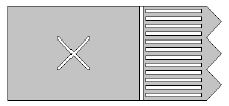
¶ Touchdown Zone Marking
A touchdown zone is provided for all ILS equipped runways and runways where additional identification of the touchdown zone is required.
Touchdown zone markings consist of pairs of rectangular markings placed symmetrically to both sides of the runway centreline. The number of pairs is related to the LDA available:

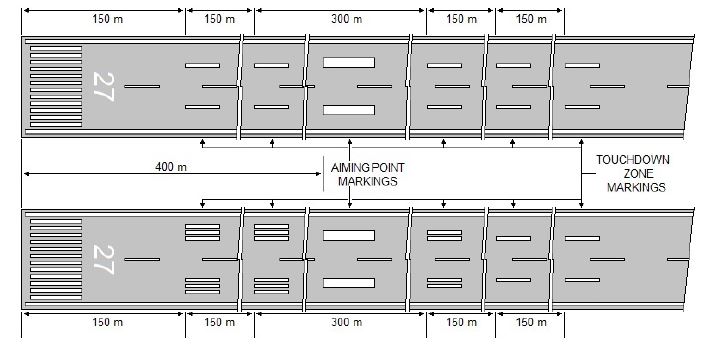
¶ Runway Edge Marking
Runway edge markings are provided on ILS equipped runways and runways where the declared runway width is less than the paved width.
Runway edge markings consist of white lines along the runway edge.
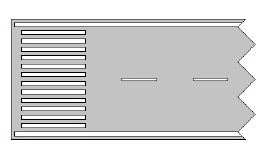
¶ Taxiway markings
Taxiway markings are:
- Centre line
- Runway holding points
- Intermediate taxiway holding points
- Edge marking
- Closed cross for closed taxiways
All these taxiway markings are yellow.
Here are some examples of taxiway markings:
¶ Taxiway edge markings
This indicates that beyond the marking the surface bearing strength is
less than the taxiway, or the area is not intended for aircraft use.
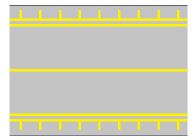
¶ Intermediate taxiway holding point
This indicates that the pilot shall take into account this intermediate crossing holding point to follow the air traffic controller instructions and to ensure the safety of nearby aircraft.
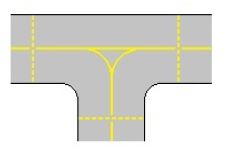
¶ Runway holding point pattern A
This marks the last holding point prior entering the runway.
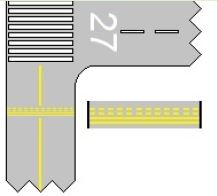
¶ Runway holding point pattern B
This marks a CAT II/III holding point where a closer holding point to the runway is provided.
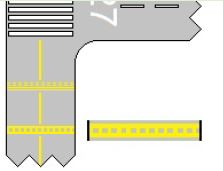
¶ Enhanced taxiway centerline
Enhanced taxiway centreline marking extends from runway holding point Pattern A away from the runway for 45 meters, or the next runway holding point if this is located within 45 meters.
This may be provided, as part of measures against runway incursions.
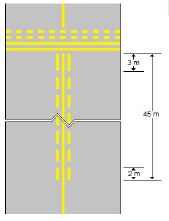
¶ Yellow cross
This indicates that the taxiway is unfit for the movement of aircraft. Taxi operations are forbidden.

¶ Mandatory instruction marking
Where it is impractical to place mandatory instruction signs, or as a supplement, some mandatory instruction markings may be provided on taxiways.
Mandatory instruction markings consist of a red background with a white inscription.
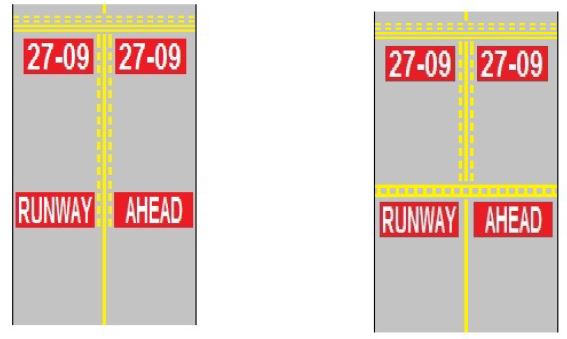
As the figure shows us, we can find the runway numbers and warning messages in order to minimize runway incursions.
¶ Information marking
Where it is impractical to place Information signs, or just in addition to information signs, information markings may be provided.
Information markings indicating a location consist of a black background with a yellow inscription. Information markings indicating a direction consist of a yellow background with a black inscription.
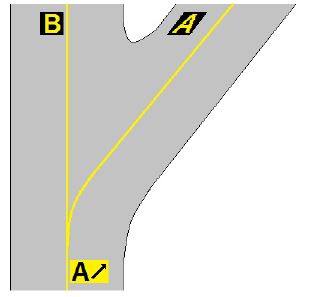
¶ Aerodrome signalization
In addition to taxiway marking signs, in airfields, you can find additional signalization close to the taxiways.
¶ Mandatory Signs
Mandatory instruction signs indicate a location beyond which an aircraft shall not proceed without ATC clearance.
Mandatory instruction signs consist of a red background with a white inscription. They are located at runway holding points on both sides of the taxiway.
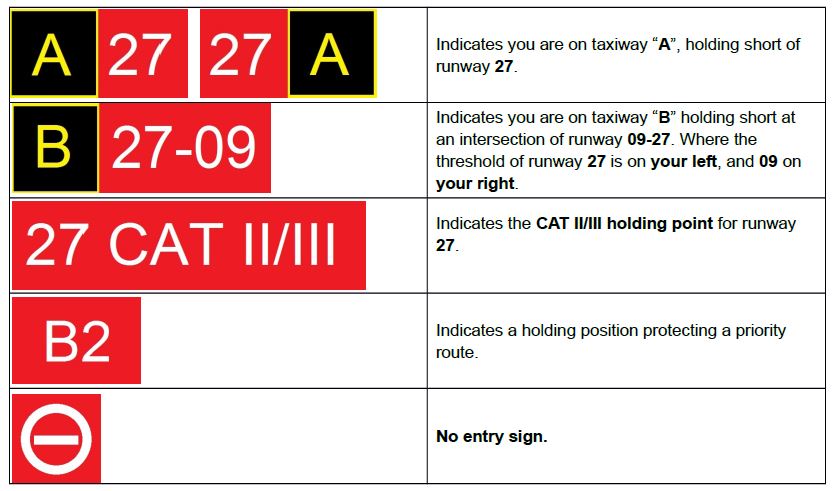
At uncontrolled airports, all care must be taken before proceeding. Mandatory instruction may be supplemented by location signs.
¶ Information Signs
Information signs indicate either a location or a routing.
- Location signs consist of a black background with a yellow border and a yellow inscription.
- Direction signs consist of yellow background with a black inscription.
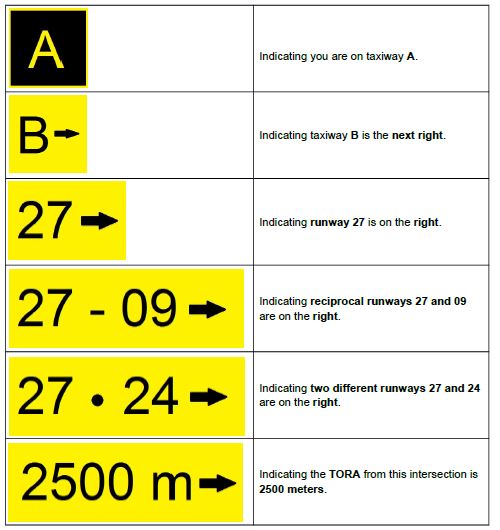
Information signs are usually located on the left side of the taxiway.
TORA = Take-off run available distance
- ICAO Documentation Annex 14 - Aerodromes - Volume I - Aerodrome Design and Operation - 8th Edition July 2018 - Chapter 5 & 7
- VID 150259 - Creation
- VID 435695 - Wiki integration
- VID 496402 - Wiki.js integration